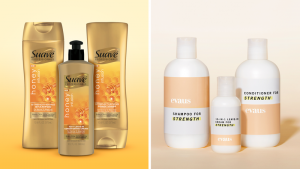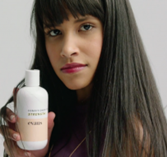
The beauty industry has long been regarded as the epitome of luxury, with costly formulas, exorbitant ingredients and prestigious brand names demanding consumers take out an investment if they want to look as good as the model in the ad.
Thanks to affordable but high-quality brands such as Beauty Pie, NYX Cosmetics and e.l.f, we’re slowly learning that price doesn’t always equate to performance, but apparently not fast enough according to Suave Beauty.
The U.S brand’s experiment involved changing the design of their packaging from drugstore-friendly to the minimal pantone-coloured kind that millennials go crazy for, not to mention a sleek name change (Evaus – original, right?).
The new products were distributed to a variety of beauty influencers who regularly partner with high-profile brands, with each trying the product before taking part in a video campaign promoting the new range.
Each influencer fell in love with the collection, commenting, “I instantly fell in love with these products,”, “they left my hair so strong and healthy,” and “these were game-changing.”
Terri Goldstein, CEO of branding company, The Goldstein Group told Professional Beauty last year that brand seduction plays out packaging first.
“Colour is first, shape is second, symbols are third and words are last,” she says.
This social experiment is a testament to the role packaging plays when it comes to marketing beauty products. Any brand, drugstore or prestigious, can spend multi-millions on marketing and aesthetics, but when it comes down to it, it’s the quality of the formula that matters, and if a more inexpensive brand can deliver it, should we make the switch?

A recent study claimed that half of your customers can’t tell the difference between designer and budget makeup when they are applied to the face.
Beauty and health retailer’s Superdrug and A.S. Watson Group claim that 48% of those surveyed could not tell the difference between one look costing £10 and the other £100. Apparently, only 12% of shoppers could accurately identify the premium products once they’d been applied.
Two looks were created using five products from both budget and premium brands (the one on the left was created with budget brands, while the one on the right uses designer brands), with look one costing just £9.97 and look two costing £100.50.
“You’d have to have a real eagle eye for premium beauty to tell the difference between a £3 lipstick and one costing £40,” a spokesperson for the beauty retailer told Daily Mail UK.
“This test proves that when it comes to makeup, paying more isn’t about the face you’re wearing, it’s about the packaging and being swayed by million pound advertising campaigns.”
“If savvy women are just after the latest looks then this research proves it really isn’t worth paying more.”
There have been multiple cosmetic comparison tests throughout the years, with Cosmopolitan USA, Bustle and Allure resolving that packaging and marketing plays a major role in price variation rather than ingredients.
Despite this, ‘you get what you pay for’ is still a commonly held ideal, and aesthetics and branding will always play a major role in conveying a sense of luxury to clients.
It’s up to your customers if the extra cost for high-profile brand treatments is justified, but not everyone has the same priorities. In the end, it’s up to your customer and what makes them feel best.
Related
- The world’s most powerful beauty influencers
- You need to use video marketing – NOW
- The history of waxing and why it’s here to stay
- Instagram’s new feature changes the online booking landscape
- Gold Coast salon starts new nail trend

